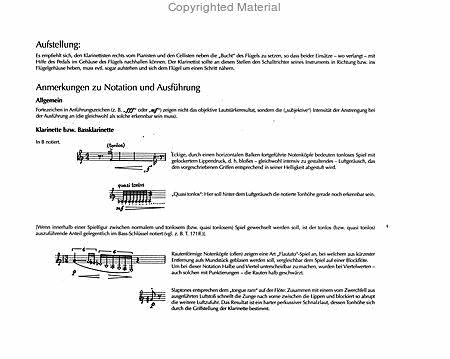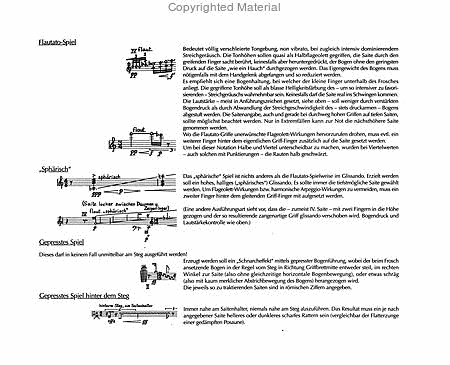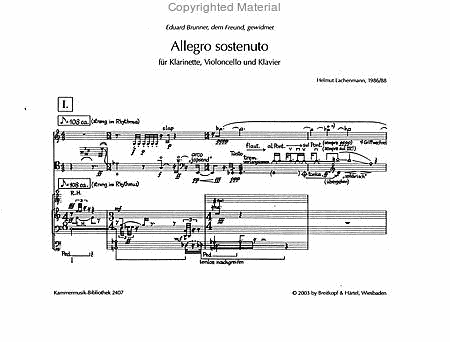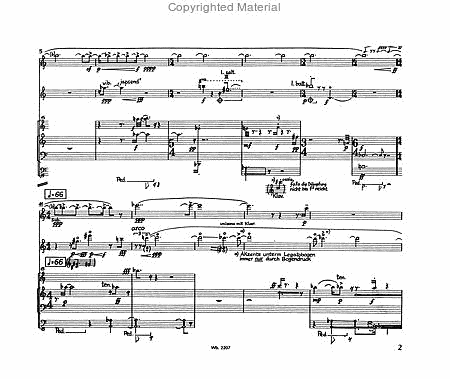
Happy Present Meet
Lachenmann Allegro Sostenuto for Clarinet (or Bass Clarinet), Cello and Piano
practical score
Genres: 20th Century
World premiere: Cologne, December 3, 1989 / 세계 초연: 쾰른, 1989년 12월 3일
Music post-1945; New music (post-2000). Performance score.
Composed 1986/88.
Duration 32'.
In retrospect, the world premiere of Helmut Lachenmann's Allegro sostenuto in December 1989 at the Cologne Philharmonie can be seen as a kind of re-birth of chamber music in the late 20th century. In countless concerts and at least four CD recordings, Lachenmann's large-scale clarinet trio has since offered ample evidence that it has a clarity of contour coupled with a shading of sonorities that I cannot imagine anywhere else besides Debussy (Jurg Stenzl). The new performing score will considerably facilitate the access to the work.As in my earlier work Ausklang for piano with orchestra, here, too, the musical material is determined by a mediation between the experience of resonance (tenuto variations between a secco sound and natural or artificial laisser-vibrer) on the one hand, and movement on the other. Both aspects of the sounds confront each other in the conception of structure as a highly ambivalent arpeggio, i. e. as a successively experienced process of building up, tearing down, and rebuilding, which is also communicated within the briefest space of time as a figurative gesture, as if it were a projection onto larger surfaces.Form and expression result in the combination of six successively ordered zones: A broad opening sequence (1), which traverses down through sonic space, presents a legato cantilena of simple - both natural and artificial, direct and indirect, false as it were - extensions of the resonance or fields of resonance, the last of which are cadenced to a stand-still (Standstill here is a concept in which resonance and movement in their most extreme forms come in contact). (2) is a variously subdivided play of terraces drying out between secchissimo and total pedalisation. In the actual allegro section (3), resonance appears to flow in a motion with intense velocity - or vice versa. Interrupted and diverted by a sort of deflated hymn, (4) is a recitative of calls in spaces that resonate to various degrees, including some dead spaces. In (5) they find their way back to movement, escalating, consuming themselves in marginal regions of the violently perforated instrumental sound. Feathering out, as it were, a final cadence (6) is composed of mixtures, in whose inner life resonance and movement once again become merged.(Helmut Lachenmann, translated by Steven Lindberg and edited by Richard Steinitz / program notes for the Huddersfield Festival 2000)CDs:Alain Damiens, Pierre Strauch, Pierre-Laurent AimardCD Accord 202082Eduard Brunner, Walter Grimmer, Massimiliano DameriniCD col legno WWE 31863David Smeyers, Michael Bach, Bernhard WambachCD cpo 999 102-2Shizuyo Oka, Lucas Fels, Yukiko SugawaraCD KAIROS 0012212KAIensemble phorminxCD WER 6682 2Bibliography:Griffiths, Paul: Modern Music and After, 3rd edition, Oxford University Press 2010, p. 283f.Lachenmann, Helmut: Komponieren: Ein Instrument bauen, zum Beispiel Allegro Sostenuto, in: Komposition und Musikwissenschaft im Dialog I (1997/1998), hrsg. von Inka Misch und Christoph von Blumroder (= Signale aus Koln. Beitrage zur Musik der Zeit, Band 3), Saarbrucken: Pfau 2000, pp. 114-142.Lang, Benjamin: Im Wirbel der Zeiten. Gerard Griseys Widmung an Helmut Lachenmann in ,,Vortex Temporum, in: Lost in Contemporary Music. Neue Musik analysieren, hrsg. von Benjamin Lang, Regensburg: ConBrio 2017, pp. 145-171.Mauser, Siegfried: Coincidentia oppositorum? Zu Helmut Lachenmanns Allegro sostenuto, in: Nachgedachte Musik. Studien zum Werk von Helmut Lachenmann, hrsg. von Jorn Peter Hiekel und Siegfried Mauser, Saarbrucken: Pfau 2005, pp. 137-144.Mosch, Ulrich: Das Unberuhrte beruhren Anmerkungen zur Interpretation von Helmut Lachenmanns Werken Pression und Allegro sostenuto, in: Musik inszeniert. Prasentation und Vermittlung zeitgenossischer Musik heute, hrsg. von Jorn Peter Hiekel (= Veroffentlichungen des Instituts fur Neue Musik und Musikerziehung Darmstadt, Band 46), Mainz u. a.: Schott 2006, pp. 25-46.ders.: : bis ins kleinste detail. Zu einer Skizze von Helmut Lachenmanns Allegro sostenuto, in: Neue Zeitschrift fur Musik 167 (2006), Heft 1, p. 34F.Neuwirth, Markus: Strukturell vermittelte Magie. Kognitionswissenschaftliche Annaherungen an Helmut Lachenmanns Pression und Allegro sostenuto, in: Musik als Wahrnehmungskunst. Untersuchungen zu Kompositionsmethodik und Horasthetik bei Helmut Lachenmann, hrsg. von Christian Utz und Clemens Gadenstatter (= musik.theorien der gegenwart 2), Saarbrucken: Pfau 2008, pp. 73-100.Smeyers, Davis: Allegro Sostenuto, in: The Clarinet, Mai/Juni 1998, pp. 26-28.
회고해보면, 1989년 12월 쾰른 필하모닉에서 열린 헬무트 라헨만의 알레그로 소스테누토 세계 초연은 20세기 후반 실내악의 일종의 부활로 볼 수 있다. 수많은 콘서트와 적어도 4개의 CD 녹음에서, 라헨만의 대규모 클라리넷 트리오는 그 이후로 드뷔시(위르그 슈텐츨) 외에는 상상할 수 없는 음색의 음영과 더불어 윤곽의 명확성을 가지고 있다는 충분한 증거를 제공했다. 새로운 연주 악보는 작품에 대한 접근성을 상당히 용이하게 할 것이다. 오케스트라와 함께 하는 피아노를 위한 나의 이전 작품인 아우스크랑에서와 마찬가지로, 여기에서도 음악적 소재는 한편으로는 공명(세코 사운드와 자연적 또는 인공적인 레이서-비브러 사이의 테누토 변형)의 경험과 다른 한편으로는 움직임 사이의 중재에 의해 결정된다. 사운드의 두 측면은 매우 모호한 아르페지오로서의 구조 개념에서 서로 마주한다. 즉, 쌓아올리고, 허물고, 재건하는 과정을 연속적으로 경험하는 것으로, 비유적인 제스처로서 가장 짧은 시간 내에 전달되며, 마치 더 큰 표면에 투사하는 것처럼 보인다. 형태와 표현은 연속적으로 정렬된 여섯 개의 구역의 조합으로 나타난다. 음향 공간을 가로지르는 넓은 오프닝 시퀀스(1)는 공명 또는 공명 장의 단순한 - 자연스럽고 인공적, 직접적이고 간접적, 거짓된 - 확장의 레가토 칸틸레나를 제시하며, 마지막은 정지 상태로 리듬을 맞춘다(여기서 정지는 공명과 움직임이 가장 극단적인 형태로 접촉하는 개념이다). (2)는 세키시모와 완전한 페달리제이션 사이에서 말라붙는 테라스의 다양하게 세분화된 연주이다. 실제 알레그로 섹션(3)에서 공명은 강렬한 속도로 움직이는 것처럼 보인다 - 또는 그 반대의 경우도 마찬가지다. (4)는 일종의 수축된 찬송가에 의해 중단되고 전환되어 다양한 정도로 공명하는 공간에서 호출을 낭송하는데, 여기에는 몇몇 죽은 공간도 포함됩니다. (5)에서 그들은 움직임으로 돌아가는 길을 찾고 격렬하게 천공된 악기 소리의 한계 영역에서 스스로를 소모합니다. 깃털처럼 퍼지는 마지막 카덴스(6)는 혼합물로 구성되어 있으며, 그 내면의 삶에서 공명과 움직임이 다시 한 번 합쳐집니다.(Helmut Lachenmann, Steven Lindberg 번역, Richard Steinitz 편집 / Huddersfield Festival 2000 프로그램 노트)CD: Alain Damiens, Pierre Strauch, Pierre-Laurent AimardCD Accord 202082Eduard Brunner, Walter Grimmer, Massimiliano DameriniCD col legno WWE 31863David Smeyers, Michael Bach, Bernhard WambachCD cpo 999 102-2Shizuyo Oka, Lucas Fels, Yukiko SugawaraCD KAIROS 0012212KAIensemble phorminxCD WER 6682 2참고 문헌: Griffiths, Paul: Modern Music and After, 3판, Oxford University Press 2010, p. 283f.Lachenmann, Helmut: Komponieren: Ein Instrument bauen, zum Beispiel Allegro Sostenuto, in: Komposition und Musikwissenschaft im Dialog I (1997/1998), hrsg. von Inka Misch und Christoph von Blumroder (= Signale aus Koln. Beitrage zur Musik der Zeit, Band 3), Saarbrucken: Pfau 2000, pp. 114-142.Lang, Benjamin: Im Wirbel der Zeiten. Gerard Grisey의 Widmung an Helmut Lachenmann, Vortex Temporum, in: Lost in Contemporary Music. 새로운 음악 분석, hrsg. von Benjamin Lang, Regensburg: ConBrio 2017, pp. 145-171.Mauser, Siegfried: Coincidentia oppositorum? Zu Helmut Lachenmanns Allegro sostenuto, in: Nachgedachte Musik. Studien zum Werk von Helmut Lachenmann, hrsg. von Jorn Peter Hiekel und Siegfried Mauser, Saarbrucken: Pfau 2005, pp. 137-144. Mosch, Ulrich: Das Unberuhrte beruhren Anmerkungen zur Interpretation von Helmut Lachenmanns Werken Pression und Allegro sostenuto, in: Musik inszeniert. Prasentation und Vermittlung zeitgenossischer Musik heute, hrsg. von Jorn Peter Hiekel (= Veroffentlichungen des Instituts fur Neue Musik und Musikerziehung Darmstadt, Band 46), Mainz u. a.: Schott 2006, pp. 25-46.ders.: : bis ins kleinste 세부사항. Zu einer Skizze von Helmut Lachenmanns Allegro sostenuto, in: Neue Zeitschrift fur Musik 167 (2006), Heft 1, p. 34F.Neuwirth, Markus: Strukturell vermittelte Magie. Kognitionswissenschaftliche Annaherungen an Helmut Lachenmanns Pression und Allegro sostenuto, in: Musik als Wahrnehmungskunst. Untersuchungen zu Kompositionsmethodik und Horasthetik bei Helmut Lachenmann, hrsg. von Christian Utz und Clemens Gadenstatter (= musik.theorien der gegenwart 2), Saarbrucken: Pfau 2008, pp. 73-100.Smeyers, Davis: Allegro Sostenuto, in: The Clarinet, Mai/Juni 1998, pp. 26-28.
작곡가 Lachenmann,Helmut




Ives String Quartet No.2 (Score Only)
Lutoslawski Livre Pour Orchestra for Score
Scriabin Le Poeme de l`extase-The Poem of Ecstasy Op.54 (Full Score)
Holliger Erde und Himmel for Tenor, Flute, Violin, Viola, Cello and Harp (Miniature Score)
Chin Unsuk 진은숙 Cello Concerto (Miniature Score)
Xenakis Eonta (Miniature Score)
Lutoslawski Concerto for Orchestra (Miniature Score)
Murail La Barque mystique (Score)
Stockhausen Mixtur No. 16 for 5 Orchestral groups (Full Score)
[특가상품] Berio Concerto for 2 Piano and Orchestra (3 Piano 6 Hands)